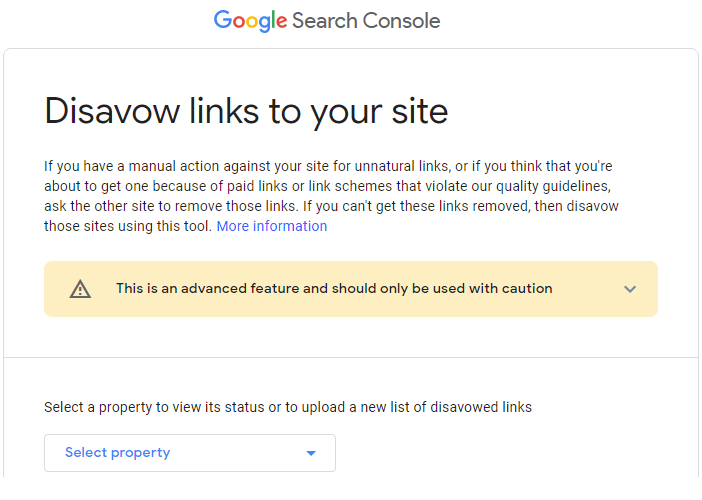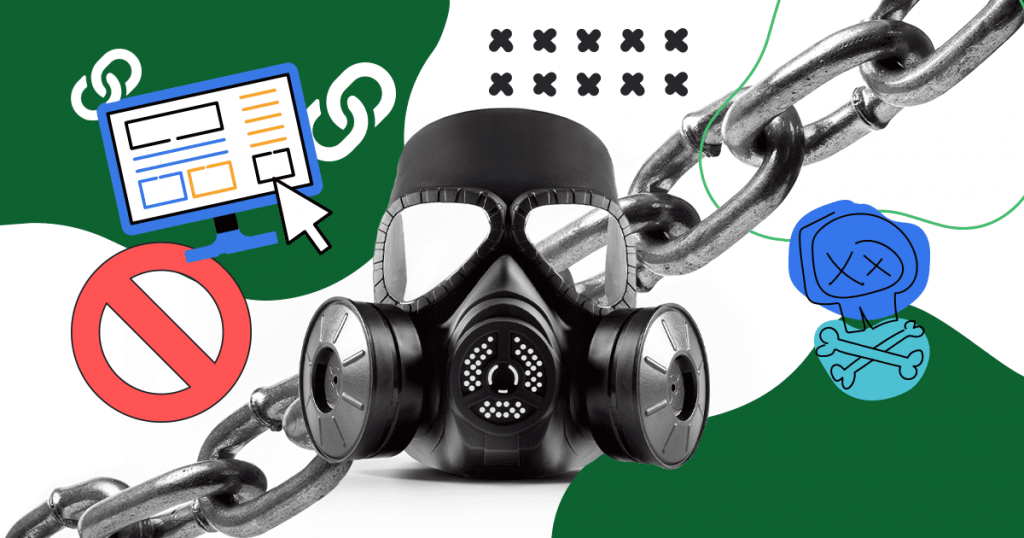No SEO campaign can be considered complete without a strategy for building a robust backlink catalog.
High-quality backlinks tell search engines like Google and Bing that you’re out there producing great content other people find helpful, informative, and entertaining.
Think of them as “votes of confidence” from peers who like what you do and want to see you do more of it.
The more of them you have, the more valuable your content is considered to be.
But not all backlinks are equal to one another. Toxic backlinks can hurt your SEO efforts and perhaps even put you in the doghouse with the search engines.
That said, it’s crucial to understand how to spot them and what you can do to get rid of them.
Here is what we will cover in this blog post:
- First of All, What is a Quality Backlink?
- What is a Toxic Backlink?
- What Makes a Backlink Toxic?
- 5 Main Types of Bad Links You Should Avoid
- How Can Toxic Backlinks Affect your Organic Performance?
- How Can You Find Toxic Backlinks?
- How to Fix Toxic Backlinks
- How to Avoid Toxic Backlinks Moving Forward
- Wrap Up
First of All, What is a Quality Backlink?
Quality backlinks remain one of the most crucial Google ranking factors, so it’s essential to know what factors truly set a good example apart from all the rest.
In contrast to toxic or bad links, a quality backlink is a backlink that’s been duly earned, meaning someone came across it organically, found value in it, and elected to share it with their own audience via a backlink.
You may occasionally see this type of backlink described as earned backlinks or as having been “editorially placed.”
Here are a few other characteristics of quality backlinks to keep in mind.
- They come from trusted authority sources, like highly relevant publications, high-level industry influencers, respected blogs or journals, etc.
- They’re embedded within content that properly aligns with your content regarding the topic and industry. (The more relevant, the better.)
- They have a high potential for sending high-quality traffic your way.
The more backlinks you can add to your catalog that meet the above criteria, the more helpful they’ll be in raising your Google rankings.
What is a Toxic Backlink?
Toxic backlinks are links that don’t come from high-quality, trusted authority sites.
As a result, they can and will hurt your SEO if there are enough of them, so it’s essential to know how to spot them and understand what to do if you find you have them.
All modern website owners understand how important backlinks are.
They also know that you want a lot of them if you’re serious about your SEO efforts. Unfortunately, that means most people adopt a “more is more” approach to collecting backlinks.
However, good backlink building isn’t about scoring as many links as possible. It’s about earning high-quality, relevant links from the right sources.
What Makes a Backlink Toxic?
Google considers any link placed solely to manipulate search engine rankings to be a violation of their official webmaster guidelines.
That said, any link that looks like it may have been placed for that reason is toxic and has the potential to damage your search engine rankings.
Toxic links are links that:
- Come from websites that exist solely for the purpose of linking out to other sites — “link farms”.
- Come from sources that aren’t relevant to the linked content.
- Come from sites that aren’t Google indexed.
- Are hidden in a website footer or forced into a blog comment.
- Are present on all or most of the pages of a particular website.
- Are marked as sponsored.
5 Main Types of Bad Links You Should Avoid
Before you can come up with a good strategy to remove toxic backlinks, you need to know precisely what types of links qualify, as well as how each type contributes to a toxic score.
Here are a few common examples every digital marketer should know.
1. PageRank-Passing Paid Links
PageRank is not the only algorithm Google uses to determine which sites should rank where on a SERP these days, but it’s nevertheless a significant one.
Its purpose is to determine how relevant a particular site is by counting the links that point back to it and weighing their quality.
That said, it’s OK to pay for links that don’t pass PageRank along to the linked site. However, paying for links that do is a clearly stated violation of Google’s webmaster guidelines.
For that reason, paid links should always use a qualifying attribute (such as rel=“sponsored”) to signal that they are not organic in nature.
2. Links That Lack Relevance
It’s really not possible to overemphasize the importance of relevance when it comes to achieving top Google rankings.
Once upon a time, you may have been able to game the system by accumulating backlinks from as many high-ranking sites as possible without caring whether they were related to your content, but those days are long over.
These days, Google can easily tell whether a link represents a genuine vote of confidence from the site owner or publisher, and relevance is one factor it looks at to determine this.
For example, a bunch of backlinks from beauty websites not only won’t benefit you if you run an automotive website but will likely even hurt you.
3. Comment Spam
Toxic backlinks don’t necessarily have to appear within the body of a webpage or blog article to potentially hurt your standing with Google.
t’s enough for links back to your site to be part of an SEO tactic with a longstanding reputation for abuse.
So what are toxic backlinks like when they show up within this context? They can often appear as keyword-stuffed links in discussion forums.
However, spammy comments littered across the comment sections of multiple blogs are highly toxic, as well.
This isn’t to say you can never link back to your site within these contexts, but you do need to be careful how you do it.
Make sure links are topically relevant, high in quality, and natural-looking. No keyword-stuffing or spammy language.

4. Links from Poor-Quality Sites
It’s not just the relevance of the site linking back to you that determines the difference between toxic backlinks and quality ones.
It’s also the overall quality of the site doing the linking. Backlinks from poor-quality sites will almost certainly get you penalized by Google sooner or later.
The worst sites are sites that were clearly created solely for SEO purposes. This means they don’t provide any actual value to an audience.
Instead, they’re basically link farms stuffed with barely readable spun content, intrusive advertising, and perhaps even random lists of links without any context at all.
5. Header and Footer Links
Since headers and footers reliably (but inconspicuously) appear on every page of a particular website, they might seem like logical spots to place a particularly important backlink.
However, you should definitely be aware that today’s Google algorithms can see right through tactics like those.
As with links placed within the signature footers of discussion forums, this practice is almost universally seen as an attempt to game the algorithm and cheat the system.
So if Google catches it, both the site doing the linking and the site being linked to will likely be penalized.
How Can Toxic Backlinks Affect your Organic Performance?
Search engine algorithms have evolved a lot over the years, so the days when toxic backlinks simply slipped under the radar are long over.
Now, search engines are looking for quality over quantity, and they’re becoming more competent by the day at recognizing it.
So not only can you be rewarded for having lots of quality backlinks, but you can be penalized for poor quality links as well.
To begin with, you can be formally penalized by the search engines. This is often done automatically via an algorithm filter, but real human beings will sometimes still do it, too.
In fact, if a member of Google’s spam team happens to review your site and decides it’s not adherent to their webmaster guidelines, they likely will apply a manual penalty.
Your competitors can also file spam reports against your site. The effects of any applied penalties include:
- A sharp decline in organic web traffic to any affected pages.
- Drastically reduced search engine visibility.
- Disregard of your link building efforts by the search engines.
And worst of all, if your site is added to an algorithmic filter as part of a penalty adjustment, you will likely never know it for sure.
You probably won’t be notified, and there’s no way to appeal the penalty or have it removed.
The only way out of the situation is to perform a link audit and work to eliminate any links that could be considered toxic.
How Can You Find Toxic Backlinks?
Every web admin or SEO professional needs to be aware of toxic backlinks and make searching for them part of their ongoing search engine optimization efforts.
If you have noticed a steep decline in web traffic that might signal a penalty, you should do an audit at your earliest convenience.
However, many webmasters choose to do them routinely to spot potential issues before they impact rankings.
Get the raw data
Backlink audit tools take a lot of the guesswork out of gathering the data you need to launch an audit, and there are plenty to choose from out there (like Semrush, Ahrefs, Serpstat and GrowthBar).
Pick your favorite, set up an audit, and set your desired parameters. The tool will then search the web for existing backlinks that fit your criteria.
Many options further allow you to connect your tool to your Google Search Console to gain additional insights.
Start assessing each toxic backlink
Your audit tool will single out some of your links and let you know they’re toxic, as well as sort them according to how potentially harmful they are.
The next step is to go over each entry in the list and identify the ones impacting your site the most.
Anything with a high toxicity score should definitely be addressed.
You might also see listings that you know are legitimate or that have a very low toxicity score. Add these links to a whitelist to help separate them from everything else.
How to Fix Toxic Backlinks
Once you’ve whitelisted the backlinks you’d like to keep, it’s time to get to work on what’s left.
There are two basic options you have as to how to address them. You can either take steps to have the backlink removed, or you can add them to a disavow list.
Here’s a look at how to proceed with either option.
Removing Toxic Backlinks
In the case of super-toxic links, a complete removal is probably the best option, so you’ll need to build a list of examples to work from using your audit tool.
To remove a link, there needs to be an email address available for the underlying domain so you can contact an admin and make the request. (If there’s no email address, you’ll need to disavow the link instead.)
Use your audit tool to connect your email address and send a bulk request to the domains behind your toxic links. You can also ask that links be changed from “follow” to “no follow.”
Then keep an eye on the status of your requests. Follow up as needed until everything’s taken care of.
Disavowing Toxic Backlinks

When and where removals either aren’t successful or aren’t an option at all, you’ll want to disavow the toxic links in question to repair your search engine ranking.
Disavowals are requests sent to Google to ignore the links in question to ensure they no longer impact your site’s reputation.
This is done by using Google Disavow Tool to upload a disavow file containing the specified links.
From there, you’ll need to wait patiently for Google to address them, which can take up to six weeks.
Here’s an example of how to find and disavow toxic backlinks using Ahrefs and Google Webmaster Tools:
How to Avoid Toxic Backlinks Moving Forward
Once you’ve taken care of any existing toxic backlinks, you’ll naturally want to prevent the same thing from happening again in the future. Here are some tips to keep in mind.
Avoid paying for backlinks
All those services out there that offer to hook you up with hundreds or thousands of backlinks in exchange for a small fee sound too good to be true for a reason.
The quality of those links will likely be questionable at best, so you run a substantial likelihood of hurting your SEO efforts.
Even links marked as sponsored can damage your ranking, so it’s best to play it safe here.
And make sure any links you post on your site yourself are there for genuine editorial purposes, as well.
If you do need to add links that don’t qualify to your site, tag them as “no follow” to neutralize any toxicity.
Steer clear of exact-match anchor text links
If you create links using anchor text that exactly matches your target keywords and phrases, there’s a risk search engines might see them as toxic.
Of course, keyword stuffing is a no-no anyway, especially when people are new to SEO, but adding backlinks to the mix only worsens the situation.
If you need some help finding high-quality backlinks that fit your SEO strategy, you must try the AI Backlink Matcher. This tool will match your brand to others alike and create partnership opportunities to help you build your backlink profile and website authority.
Don’t add backlinks to comments
Although adding links to your pages to comments made on other blogs may sound like an innocent, easy way to boost SEO, it’s not a good idea.
The thing is, Google is quite smart these days and getting smarter all the time, so it knows what you’re up to when you do this.
The owners of the websites you target probably know, as well, and they’re not going to appreciate it.
They may even mark your comments as spam, which isn’t going to help your case.
Perform regular backlink audits
In addition to keeping your own link building efforts clean, the best thing you can do to avoid toxic backlinks is adding regular auditing to your ongoing SEO to-do list.
This allows you to spot and address problematic links before they hurt you.
For best results, run a quick audit twice a month. Your audit tool of choice may have an option for automating this, so take advantage of it.
You may also be interested in these articles:
- Discover Why Broken Links Occur and How to Resolve Them
- What are Reciprocal Links? Are they good or bad for your SEO?
- Should you Focus on Getting .gov and .edu Backlinks?
Wrap Up
The key to getting the stellar results you’re after with your SEO campaign is to make sure all your bases are covered.
Monitoring your backlink catalog for potential issues is one important (but often overlooked) aspect of this. Regularly assessing the maturity of your overall SEO strategy is another.
Take our short but helpful SEO maturity assessment to help assess the strength of your current campaign, and find out what you need to know to improve it.
You’ll learn what your strengths are, identify your weaknesses, and adequately prepare to take your SEO efforts to the next level!









